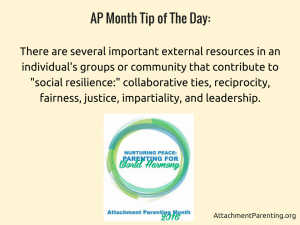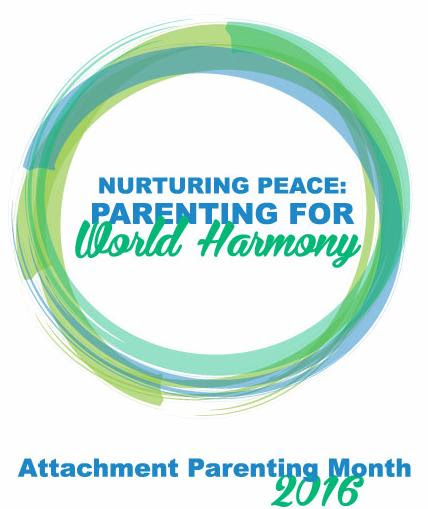Category: Use Nurturing Touch
The greatest gift…
What is going on behind closed doors?
 We, as a society, have to change the way we live.
We, as a society, have to change the way we live.
It’s just that simple, and just that hard.
We are shocked nearly every day by news of another seemingly senseless, violent act. We have names for the big ones — Columbine, Sandy Hook, Omaha mall shooting, Dallas — helping us remember the victims and helping us process the overwhelm of confusion, sadness, anger, and the inexplicable that we felt when we found out. It’s getting harder to name these shootings, stabbings, even bombings — there’s just too many of them, happening too frequently, and worse of all, it’s becoming almost commonplace to hear about them. We are desensitizing.
Except for in war, or in other chronically unsettled parts of the world, there seemed to be a long period of time when we just didn’t hear of these types of events happening to Americans. Perhaps there were more acts of violence in schools, workplaces, and communities before Columbine in 1999 and the news at the time just didn’t pick up on them?
But I have a different theory. Our culture has changed. Society is far less accepting of violent tendencies. We are appalled to hear stories of domestic violence in homes, and rightly so. No one deserves to live in an unsafe home. We all have dignity, and women should be treated as equals to men. We are working toward more nurturing relationships and positive discipline toward our children. Fewer teachers are allowed to harshly treat students that frustrate them. Overall, we cannot go around instilling fear in one another as an every day part of life. As it should be.
Except that while there are these widespread expectations to treat one another with respect, there has been less available instruction in how to do that. There is so much more support today for parents, teachers, couples, employers, and others traditionally in positions of authority in relationships. And we, as a society, are finding ways to transcend the existing gaps at a rapid pace, with such ideas as mindfulness in schools rather than issuing detention and offering free positive discipline education at local API Support Groups.
But there was a gap of widespread support that spanned at least 1 generation. From the time when the Columbine school shooting rocketed through the news, to now when cry-it-out sleep training is being openly debated rather than just merely accepted as the norm — reflecting the huge change we, as a culture, are having on the idea of relationship — there was 1 or 2 generations of individuals who were transitioning from the “old” way of relating — hierarchical and fear-based authority — to this “new” way: collaborative, emotionally literate, and focused on problem-solving. That’s a big leap from the old to the new way, and all leaps need support to bridge the gap.
We are steadily closing that gap. Nurturing parenting and related practices — like mindfulness, emotion coaching, collaborative work environments, healthy conflict resolution, nonviolent communication, overall questioning the status quo — are coming from all directions, not only from Attachment Parenting International (API) but also schools, workplaces, health care providers, community leaders, and other major sectors of society. We’re getting ideas we can put into practice at work, home, on the road, and even in the grocery store about how we can relate to one another better and resolve disagreements peacefully. This idea of living together as a nurturing community is becoming holistic.
But still we hear of these awful incidents of kids killing kids, coworkers killing coworkers, strangers killing strangers. If we thought Columbine was confusing, what do we think now as our cultural acceptance of nurturing and peaceful conflict resolution is taking hold. If this doesn’t work, what will?
We then go on to blame the news media, access to guns, leniency in sentencing, racism, politics, mental illness, and so on. The truth is, these big problem areas — like violence in society — are much bigger than a single factor, or even a few factors. It is difficult to unravel the causes, because the factors that contribute to each one seem different and ever-shifting.
The undertone to all of these is that the perpetrator in each case saw violence to be his or her best opportunity at the moment. It might have been a last resort in many cases, but it was the best option of what was left in that person’s mind. Exactly why that was the best option at the time, we probably will never know. We can speculate, but that’s only as good as guessing.
 But we do know that violence has to be planted in a person’s mind as an acceptable option, in whatever situation. Babies aren’t born violent. They are born wired to seek connection. People have to learn violence, which begins as disconnection. They learn to detach as a survival mechanism when their needs aren’t meant. There are various degrees of this, as we see in insecure attachment research, and definitely few insecurely attached children grow up to choose violence that makes the news. But that detachment is the first step to accepting violence as an option at all.
But we do know that violence has to be planted in a person’s mind as an acceptable option, in whatever situation. Babies aren’t born violent. They are born wired to seek connection. People have to learn violence, which begins as disconnection. They learn to detach as a survival mechanism when their needs aren’t meant. There are various degrees of this, as we see in insecure attachment research, and definitely few insecurely attached children grow up to choose violence that makes the news. But that detachment is the first step to accepting violence as an option at all.
I believe that we, as individuals, are not inherently violent but that it is learned. If it were so that we are innately violent, we could not be moving toward a more nurturing culture as we are.
 But our culture does have its leftovers from previous generations’ perspectives on relationship, and those leftovers are most often seen — not in the news of mass killings that we are increasingly seeing — but more in our homes, behind closed doors, when conflict arises between couples and between parents and children. Those leftovers are there when parents yell at, emotionally withdraw, or strike their children in the name of “discipline.” Those leftovers are there when babies begin life with crying it out, learning that their biological need for connection will be ignored.
But our culture does have its leftovers from previous generations’ perspectives on relationship, and those leftovers are most often seen — not in the news of mass killings that we are increasingly seeing — but more in our homes, behind closed doors, when conflict arises between couples and between parents and children. Those leftovers are there when parents yell at, emotionally withdraw, or strike their children in the name of “discipline.” Those leftovers are there when babies begin life with crying it out, learning that their biological need for connection will be ignored.
There are so many contributing factors to societal violence, but it all does start in the home — with what our children grow up with, learning what is “normal” and what is expected, learning how to “resolve” disagreements and “calm” strong emotions like frustration or disappointment…whether peacefully or with force.
We have to change the way we live, in all areas of our lives, beyond but especially behind closed doors, in order to nurture peace and live in world harmony.
Join us, starting October 1, as API explores this theme through Attachment Parenting Month. World peace begins with peace in the home.
We are parents: We are all in the business of world peace.
Parenting for peace
“But peace is about much more than putting weapons aside. It is about building a global society in which people live free from poverty and share the benefits of prosperity. It is about growing together and supporting each other as a universal family.” ~ Ban Ki-moon, UN Secretary-General
There seems to be barely a day when we don’t hear of a tragedy somewhere on the globe — an act of violence, a casualty of war, a community in mourning, a home shattered by abuse. Where is peace?
Peace in our world, our nations, our communities, our homes, ourselves — we all want it, but it can seem unattainable in the societies where we live. Or is it?
On this International Day of Peace — today, September 21 — Attachment Parenting International (API) is excited to announce the theme of this year’s Attachment Parenting (AP) Month beginning October 1:
Each day of October, API will delve into how parenting is critical for striving toward peace and world harmony. We will renew our support for the ultimate peacemakers — you, the parent.
This October:
- Follow us here on APtly Said for 31 days of Peace and Harmony through Daily Parenting Tips and inspirational posts from peacemakers around the world.
- Add your family to our Wall of Harmony.
- Submit a post, however short or long, on what “parenting for peace” means to you to be published on APtly Said during AP Month.
- Donate items to our online auction, running October 18-31.
- Keep in touch and share AP Month with friends on Facebook.
4 positive discipline ideas for toddler hitting
 Hitting is a normal toddler behavior that often begins between ages 1 ½ and 2 years old. There could be many different reasons, including the child being angry but unable to express it or you being unable to understand what he’s trying to express, a life change such as a new sibling, or simply the child wanting to explore what her hand can do and what happens when she hits.
Hitting is a normal toddler behavior that often begins between ages 1 ½ and 2 years old. There could be many different reasons, including the child being angry but unable to express it or you being unable to understand what he’s trying to express, a life change such as a new sibling, or simply the child wanting to explore what her hand can do and what happens when she hits.
So, what can parents do about it?
Shortly after my son’s 2nd birthday and right around the time my next baby was born, my son began hitting. He would hit his brother when he was angry, and sometimes he would hit my husband and me playfully, which was still something we wanted to discourage.
We tried a variety of different strategies to prevent it and teach him not to hit. Here are 4 positive discipline ideas to try if your toddler hits:
- We tried to find new, creative things to do with his hands throughout the day, such as teaching hand-clapping games, different hand gestures like thumbs-up, or sign language — just something to engage the hands in a more productive and fun manner. Sometimes, if I saw he was about to hit playfully, I would try to high-five him instead.
- We also did a lot of soft, nurturing touch with him, like rubbing his arms, and made that more of a part of our day.
- I found that it was really beneficial to give him more outlets to get out some of his physical energy: running outside, finding things that he could throw, and letting him hit a pillow.
- It was important to me to model empathy and try to show that hitting can hurt. If he did hit us, I would often make an exaggerated sad face and say how hurt I was. Once we were out of that immediate moment of his anger — or silliness, in some cases — I would remind him that hitting hurts, that we shouldn’t hit others, and that we have to use soft touch. If he was really angry, we’d talk about other concrete ways that he could express that anger instead. We made a point to model this with his stuffed animals. I have a video of my son when he was two where he hits his stuffed panda and says, “Slap panda.” After a second, he rubs the panda’s arm gently, hugs it, and says, “No, hug. Hug panda!”
What’s most important during a hitting situation is to stay calm and to remember that it is normal part of toddler development. It’s a phase that will pass, and the 4 ideas above may be some techniques to help it pass a little more quickly and smoothly.
Reading between the lines, Part 3: Trusted Resources
Editor’s note: There are continually media reports coming out about parenting approaches, including Attachment Parenting. Some are affirming. Others are worrying. It’s important that we know how to read between the lines on media reports regarding Attachment Parenting so that we can make informed decisions. That’s why Attachment Parenting International compiled this sampling of trusted resources for parenting information, in addition to consumer media guidelines and additional guidelines for reading scientific studies:
FamiliesForConsciousLiving.org
Reading between the lines, Part 2: Get the Most Out of a Scientific Study
Editor’s note: There are continually media reports coming out about parenting approaches, including Attachment Parenting. Some are affirming. Others are worrying. It’s important that we know how to read between the lines on media reports regarding Attachment Parenting so that we can make informed decisions. That’s why Attachment Parenting International (API) created consumer media guidelines for parents. Here are additional guidelines specific to reading scientific studies:
 Unless you’re an academic, you’ll probably find research studies to not be the easiest material to digest, but if the science behind parenting matters to you, it’s important to check out studies you learn about through the media. Here are tips to help you skim through a study without getting bogged down in scientific terms:
Unless you’re an academic, you’ll probably find research studies to not be the easiest material to digest, but if the science behind parenting matters to you, it’s important to check out studies you learn about through the media. Here are tips to help you skim through a study without getting bogged down in scientific terms:
- Read the title. What does it predict?
- Read the abstract. This is the most complete synopsis of the paper. It will outline the highlights of the study but without the necessary emphasis to allow you to make a critical assessment of the results.
- Read the last or second-to-last paragraph of the Introduction. This gives you what the abstract does not. But if you’re not familiar with the work, read the entire Introduction and pick out issues to explore separately.
- Read the first, or sometimes the last, paragraph of the Discussion. By this point, you should be able to identify the hypotheses, know what type of results to expect, and have the predictions on the experiments and their outcomes.
- Examine each Figure or Table in sequence. Read the Results associated to each Figure or Table for clarification. For issues concerning methodology, refer to the appropriate point in the Materials and Methods.
- Does the experiment address the hypothesis? Does the experiment contribute to the stated conclusions? Is the experiment central to these conclusions? Or does it provide a control? Or does it repeat previous results? Or does it contribute little to the paper?
- How well did you predict the experiment and the results?
- As you evaluate the actual results — not just the stated results — in the Figures and Tables, ask yourself: Do the results support their claim with the appropriate controls to validate the results? Do you see more in their results that they fail to address or identify? Can you identify limitations to their results or the experimental approach? Do the results address the hypotheses that you have identified?
- After reading through the Results, you should be able to identify the single-most important Figure or Table in the paper.
- Read through the Discussion to weigh the stated conclusions and claims against the evidence. Do you agree or disagree?
Reading between the lines, Part 1: Media Analysis Guidelines for Parents
Editor’s note: There are continually media reports coming out about parenting approaches, including Attachment Parenting. Some are affirming. Others are worrying. It’s important that we know how to read between the lines on media reports regarding Attachment Parenting so that we can make informed decisions. That’s why Attachment Parenting International (API) created these consumer media guidelines:
What’s Fact or Fiction in Parenting News?
Media Analysis Guidelines for Parents
 Let’s say the blogosphere is abuzz about a research study that shows that sleep-training methods like cry-it-out have no long-term effects on children or that physically punitive discipline tactics like spanking result in children who are better behaved or that birthing without drug pain relief is dangerous.
Let’s say the blogosphere is abuzz about a research study that shows that sleep-training methods like cry-it-out have no long-term effects on children or that physically punitive discipline tactics like spanking result in children who are better behaved or that birthing without drug pain relief is dangerous.
Perhaps, you’re committed to Attachment Parenting and child-rearing “news of the day” has no effect on what decisions you’ll make regarding your child in the future.
When parents who are firm in Attachment Parenting have a question about whether a child-rearing practice leads to a secure parent-child attachment bond, they feel certain that they can turn to API resources, specifically API’s Eight Principles of Parenting, the cofounders’ book Attached at the Heart, or local API Support Groups and API Leaders.
But what if you’re new to Attachment Parenting — it’s intrigued you, you’re trying it out, but you’re unsure of whether this will work for your family because it’s so different from how you were raised or how other parents around you are raising their children?
When you hear that other parenting strategies are safer and better than yours, whether that holding your baby too much will keep him from developing independence or that there’s no benefit to breastfeeding once solids are introduced — whether you’re reading this in a magazine or hearing it from your neighbor — you begin to doubt yourself and your child. You think, maybe, I got it all wrong. Maybe I should be doing this or that. Maybe I’m setting my child up for failure?
How can you know for sure that your choices in how you parent, even if opposite from others in your family, friends, or community, are right for you and your family, and are healthy for your child?
API has created these guidelines for parents to help sift through the clutter of media news reports, parenting experts, the next big thing in baby products, or even a pediatrician’s advice…basically anyone or anything that tries to influence the way you parent your child:
- Know your beliefs, values, and how these fit (or don’t fit) into the culture around you
How we parent is rooted in the legacy that we want to pass down to our children. Moral attitudes are the core of ourselves, our identity. You can identify them by recognizing the emotions attached to your preferences regarding morals. These values and beliefs may not necessarily jive with the culture in which you live. For example, a study that urges women not to choose a birth without interventions is logical for a culture where childbirth is treated like a medical emergency rather than a natural, biological event.
- Learn the back story
Every piece of advice, whether a formal research study or a book by a popular parenting author or a comment made by your child’s nurse or a quip from your mother-in-law, has a story. What is it?
Who is the person talking or writing? What is their specific field of study? What is their primary professional focus, like research, medical, policy, etc.? What is their sponsoring organization about? What theory are they citing? What is their credentials or experience? Is it in line with your values and belief system, with your goals for your child? Are researchers observing ethical standards in their treatment of study participants?
Are journalists following ethical guidelines? Dramatizing an article or blog post, also known as sensationalism, is a common way to pull readers into an article. A little punchiness isn’t bad, but it becomes unethical when the hook of a story turns into demoralizing one side of an otherwise harmless, though not necessarily controversial, topic. Journalists — which includes both writers and editors by trade, and those who share their thoughts through blogs and even comments — have great power in forming and shifting public opinion. This is why it is utterly important that mass communicators follow an ethical standard, and that their readers know the difference between ethical and unethical journalism.
What may be influencing the person giving you advice? Beware of any businesses whose goal is to sell a product or service for-profit. In terms of a research study, who is paying for it? It’s not uncommon for some well-publicized studies to be funded by organizations that lean strongly toward the results, such as a study that shows bedsharing to be dangerous that is paid for by an anti-cosleeping group.
- Beware of out-of-the-ordinary claims
Does the information offer evidence-based recommendations that follow current best practices? The majority of studies show that spanking is detrimental to child development. If a study is introduced that shows spanking to have a positive effect on children, be suspicious. Such a study isn’t valid until other studies begin to show the same results.
- Check out the facts
Any information posed as fact should have references to a credible source. An article summarizing a research study should at least provide all the information for you to look up the study yourself, if not provide you a direct link to the original abstract.
Any author or person stating something as fact, as opposed to opinion, should be able to provide you with those references. If someone quotes a statistic, look it up.
In terms of a research study itself, the sample size matters as does who is in the sample and how they were selected; random selection is desirable. What was measured and how? Are the outcome measures clearly related to the variables with which the study occurred? At least 1 long-term follow-up is desirable. When reporting observations, are the study’s authors reporting what they actually saw or are they reporting their interpretation of what they saw? Are the results of the study based on a sample of the population that would apply to you? Also, see whether the study has been replicated, if it was published in a peer-reviewed journal, and don’t forget to check out the researcher’s own discussion of limitations.
The strongest research methods for psychological studies are: qualitative findings versus quantitative; experimental rather than descriptive or correlational; controlled-experiment, meta-analysis, and observation designs over archival, case study, computational modeling, content analysis, field experiment, interview, neuroimaging, quasi experiment, self-report inventory, random sample survey, or twin study; and prospective (where subjects are recruited prior to the proposed independent effects being administered) and longitudinal (where subjects are studied at multiple time points) rather than retrospective or cross-section study.
- Notice diversity
Information that works tends to be applicable to everyone. Seek out information that doesn’t count out differences in race, marital status, ethnicity, etc., although understandably, some information such as breastfeeding only applies to a certain gender.
- Understand that the media sensationalizes
While their goal is accuracy in reporting, journalists only have so much room to write or time on the air and a controversial story angle and flashy headline is the best way to attract readers. Readers/viewers tend to side with people who share their identity, even when the facts disagree; that’s why throwing data and rational arguments at people doesn’t change attitudes. What does change attitudes is emotional storytelling, and that’s what the news media knows hooks readers. Another hook is in political motivations. Remember to ask yourself: What is the purpose of this message, and who is the intended audience, and what techniques are being used to grab and hold my attention? Add all of these factors together, and a news media report likely has gaps in critical pieces of information that affects how the information should be used by consumers.
Along these same lines, realize that nothing “proves” in research. Research may show a “correlation,” a “connection,” or may “suggest,” but there are simply too many factors in any one person’s life to “prove” an outcome. A website that currently does a good job at presenting information factually and without bias is MedicalXpress.com.
- Seek out a balanced argument
Look for sources that readily open a discussion about parenting ideas, whether new-age or traditional, and that provide all sides of a debate: risks, benefits, and alternatives. Demand transparency: Credible sources disclose their biases and conflicts of interest.
- Look for Attachment Parenting synonyms
While the merits of any parenting style should be weighed with your values and belief system, there are many parenting programs that are in line with API’s Eight Principles of Parenting but that are called by another name, such as connection, instinctive, empathic, sensitive, unconditional, peaceful, natural, and nonviolent parenting, and others do not refer to any name in particular. Attachment Parenting is an umbrella term; it includes every style of childrearing that creates and strengthens secure parent-child attachment bonds.
However, not all parenting styles are as inclusive as Attachment Parenting; some may discourage bedsharing for example or may advocate a certain parenting choice that API does not take a stance on such as cloth diapering or circumcision.




